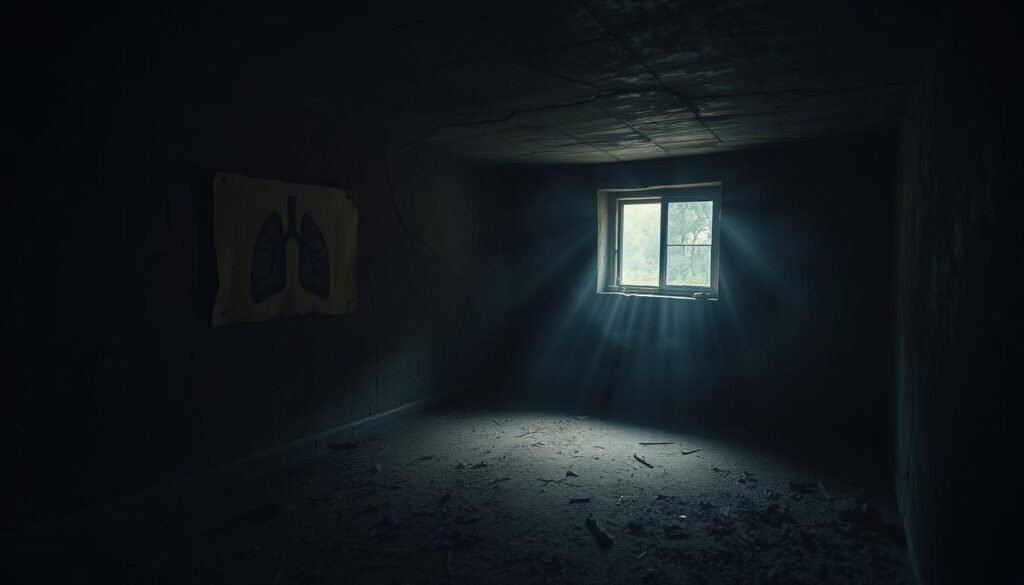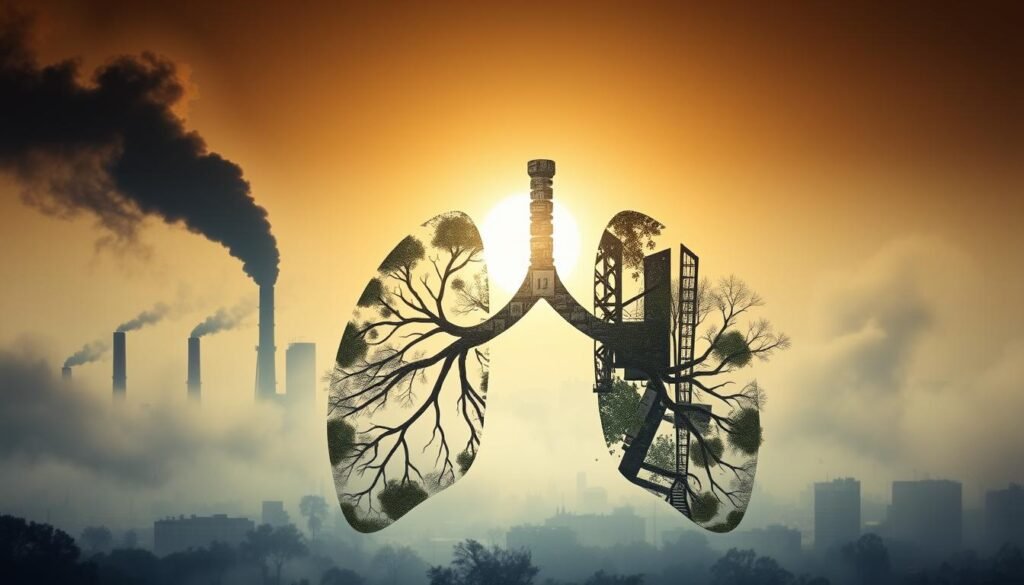A lot of people don’t know that 10-15% of lung cancer happens in those who’ve never smoked. This shows we need to pay more attention to how the environment can lead to lung cancer in non-smokers. Lung cancer is the top cancer worldwide, making up 11.6% of all cancers, based on GLOBOCAN 2018 data.
Even if someone has never smoked, they can still be at risk because of air pollution, radon, and secondhand smoke. It’s crucial to know about these dangers. Knowing more about them can help everyone stay healthier as we go about our daily lives.
Key Takeaways
- Approximately 10-15% of lung cancer cases occur in non-smokers.
- Radon gas is a significant risk for lung cancer among non-smokers.
- Secondhand smoke exposes non-smokers to carcinogenic substances.
- Air pollution is linked to tens of thousands of lung cancer deaths each year.
- Hazardous chemicals like asbestos greatly increase lung cancer risk in occupational settings.
- Over 80% of lung cancer deaths are believed to be preventable with awareness and action.
Introduction to Lung Cancer in Non-Smokers
Lung cancer is a major cause of cancer deaths, especially in non-smokers. A surprising number of people diagnosed with lung cancer have never used cigarettes. Globally, 15-20% of men and more than 50% of women with lung cancer are non-smokers. In the U.S., about 19% of women with lung cancer are non-smokers, compared to 9% of men.
The data is startling and calls for greater awareness. Non-smokers often get a different type of lung cancer. Adenocarcinoma is the most common type among them, making up 93% of their cases. Usually, non-smokers are diagnosed with lung cancer a bit later in life, around the age of 67, while smokers at 66.
Several environmental factors lead to lung cancer in non-smokers. Exposure to secondhand smoke, radon gas, and harmful agents at work are key factors. Also, mutations like EGFR and ALK mutations are more common in non-smokers. They occur in 36% and 26% of cases, accordingly. Thus, it’s vital to distinguish lung cancer in smokers from non-smokers for proper treatment and prevention.
To fight lung cancer, we need to know more about its causes. This includes genetic and environmental factors. Schools and communities should teach more about lung cancer. This is crucial for raising awareness. It’s especially important for letting people know about the risk for non-smokers.
Understanding Lung Cancer Causes
Lung cancer is a serious health issue in the US. Smoking is the top cause, but not the only one. About 10–15% of lung cancers are in people who’ve never smoked. This shows it’s a big problem for public health.
Genes also affect lung cancer risk. Certain gene mutations can make cancerous tumors grow. If lung cancer runs in your family, your risk doubles. Genetic risk can grow if you’re around environmental toxins.
Things like radon, asbestos, and secondhand smoke are dangerous. Radon gas causes 30% of lung cancer deaths in non-smokers. This gas can get into homes unseen. Plus, secondhand smoke causes 7,000 non-smoker lung cancer deaths a year.
The causes of lung cancer are still being studied. The National Cancer Institute found something interesting. Most lung cancer in non-smokers comes from body processes. They found different types of lung cancer. Some happen without any known risk factors. Looking into genetics and toxins helps us understand lung cancer better. It shows how important early detection and prevention are. For more information, check out this study.
Environmental Factors Contributing to Lung Cancer Risk in Non-Smokers
Several factors can harm lung health in non-smokers. Radon gas and secondhand smoke are at the top of this list. Both are big threats that we need to focus on.
Radon Gas: A Silent Threat
Radon gas is invisible and has no smell, but it’s radioactive. It comes from the ground and can enter homes. Being around radon gas is a big risk because it can cause lung cancer. In fact, it causes about 21,000 lung cancer deaths each year.
It’s really important to check your home for radon, especially in places where there’s a lot of it. If you find high levels of radon, installing a system to reduce it can keep your family safe.
Secondhand Smoke and Passive Smoking
Secondhand smoke is also a big danger to non-smokers, like kids and older people. Being around this smoke can lead to lung cancer. Even being exposed for a short time is harmful.
The toxic substances in secondhand smoke are just as bad as what smokers breathe in. This affects anyone nearby. To keep our lungs healthy, we should make homes and public places smoke-free.

The Impact of Air Pollution on Lung Cancer Risk
Air pollution is a big public health threat, especially for lung cancer. Around 25% of lung cancer cases are in people who never smoked. This shows the dangerous impact of air pollution. We must understand where air pollution comes from and how particulate matter affects us.
Sources of Air Pollution
Common sources of air pollution include:
- Vehicle emissions
- Industrial discharges
- Volatile organic compounds (VOCs)
These sources send dangerous particulate matter into the air, harming our environment. Air pollution does more than harm our lungs. It can also increase lung cancer risk. This is a growing concern for everyone.
Effects of Particulate Matter
Particulate matter, like PM2.5, can make respiratory conditions worse and raise lung cancer risks. Studies show:
- An increase of 10 µg/m3 in PM2.5 means a 19% rise in mortality in non-smokers.
- Long-term PM2.5 exposure is a key factor in lung cancer deaths, making up 14.1% of them in 2017.
- A 10 µg/m3 increase in PM2.5 is linked to a 73% jump in lung cancer mortality.
This data is crucial, especially for non-smokers in polluted places. A study in Europe found that even below EU limits, air pollution can cause lung cancer. This shows how widespread the problem is.

Various studies connect particulate matter with lung cancer, especially in non-smokers. This highlights the urgent need for action to reduce pollution and protect our health.
| Pollutant | Health Impact | Research Findings |
|---|---|---|
| PM2.5 | Increased lung cancer risk | HR = 1.43 for lung cancer incidence per 10 µg/m3 |
| PM10 | Lung cancer incidence increase | Association with higher rates among never smokers |
| Vehicle Emissions | Risk of non-small cell lung cancer | 250,000 lung cancer deaths attributed globally |
Asbestos Exposure and Its Link to Lung Cancer
Asbestos exposure is a major health issue, especially in work environments. It is a carcinogen used in construction, shipbuilding, and cars. People working in these fields often face risks from asbestos fibers without safe protections. The link between asbestos and lung cancer is clear, with health problems appearing years later.
Occupational Hazards: Risks in the Workplace
High asbestos exposure industries include:
- Construction
- Shipbuilding
- Asbestos mining
- Automobile manufacturing
- Firefighting
These fields lead to many asbestos-related diseases. Rescue workers from post-9/11 events also face higher risks because of asbestos dust. The chance of getting lung cancer goes up with more exposure time. Smoking and existing lung issues can make it worse. Studies show that the lung cancer risk for exposed individuals can be ten times higher than usual.
Preventing Asbestos Exposure
To prevent cancer, we must reduce asbestos at work. Employers can:
- Give workers personal protective equipment (PPE)
- Do regular safety checks and risk assessments
- Train on safe asbestos handling and disposal
- Use other materials in building and making things
It’s key for companies to follow these steps to keep workers safe from asbestos. Educating about asbestos dangers will help make strict safety rules. To learn more about asbestos risks, check out health resources on asbestos exposure and lung diseases.

Indoor Air Quality and Lung Cancer
Indoor air quality is crucial since people often spend much time inside. Indoor air pollutants like volatile organic compounds (VOCs), mold, and cleaning agents are harmful. These environmental toxins can have greater effects when combined with genes and existing health issues.
About 4 million people die early from indoor air pollution illnesses. Around 6% of these deaths are from lung cancer. Exposure to secondhand smoke (SHS) greatly increases lung cancer risk, especially in non-smoking women. Heavy exposure to environmental tobacco smoke and using solid fuels for cooking are serious risks.
To lower these risks, people can improve indoor air quality by taking specific actions. Key steps include:
- Enhancing ventilation to lower air pollutant levels.
- Using air purifiers to filter out dangerous particles.
- Choosing non-toxic cleaning products to reduce harmful exposure.
- Checking for mold and radon regularly to combat these hazards.
Being aware helps people take action against indoor air pollution and lung cancer. Every action towards a cleaner environment reduces the risk from environmental toxins.
| Source of Indoor Air Pollutants | Health Effects |
|---|---|
| Volatile Organic Compounds (VOCs) | Respiratory issues, eye irritation, potential carcinogenic effects |
| Mold | Allergic reactions, respiratory problems, lung infections |
| Household Cleaning Agents | Respiratory distress, skin irritation, long-term health risks |
| Environmental Tobacco Smoke | Increased risk of lung cancer, respiratory illnesses |
| Radon | Leading cause of lung cancer among non-smokers |
Genetic Factors and Environmental Interactions
Knowing how genes and the environment work together helps us understand lung cancer risks. This is true even for people who never smoke. While smoking is a big cause of lung cancer, non-smokers can get it too. This can happen because of things like radon, secondhand smoke, and dirty air. In fact, 15%−25% of lung cancers are found in those who’ve never smoked.
Genes play a big role in lung cancer risk. Mutations in certain genes, like CHEK2, TP53, and BRCA1, make it easier to get lung cancer. These genes are supposed to fix DNA and control how cells grow. When they don’t work right, cancer is more likely if you’re around harmful stuff.
Lung cancer in non-smokers often has to do with certain gene changes. Changes in genes like EGFR and ALK show up more in non-smokers. This makes it important to know these differences for treatment. Also, if lung cancer runs in your family, you’re at a higher risk. This shows how both your genes and environment matter.
Here’s a table that shows how different gene factors are linked to lung cancer risk in non-smokers:
| Genetic Factor | Type | Association with Lung Cancer |
|---|---|---|
| CHEK2 | Germline Mutation | Increases risk due to impaired DNA repair |
| TP53 | Germline Mutation | Linked to various cancers, including lung |
| EGFR | Somatic Mutation | Commonly found in non-smokers with lung cancer |
| ALK | Somatic Mutation | Potential target for specific therapies |
| BRCA1 | Germline Mutation | May influence cancer susceptibility |
Understanding the mix of genes and the world around us can help spot people at higher risk. This means doctors can make better plans for preventing and treating lung cancer. It’s all about personalizing how we look at risks and treatments.
Conclusion
Talking about lung cancer is crucial, especially because of its link to the environment. Many people, even those who don’t smoke, are at risk. This is especially true for people with lung problems like asthma. They face more danger if they’ve been around a lot of pollution.
We need to act on environmental dangers. Working together to lower our contact with things like radon and secondhand smoke helps. Also, knowing how bad asbestos is and keeping our air clean matters. If we catch lung cancer early and test right, we can treat it better. This shows why it’s so important to understand squamous cell lung cancer.
In fighting lung cancer, we should push for getting checked and spreading knowledge. Cleaner living can cut down our risk. For deeper insights, check out this detailed guide on squamous cell lung cancer. It’s vital we all do our part in this fight.